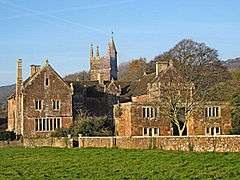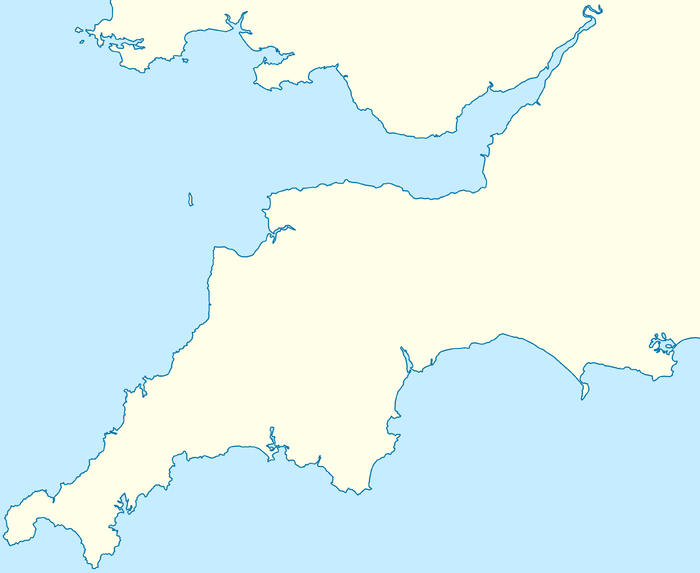John Stawell
Sir John Stawell or Stowell, 29 August 1600 – 21 February 1662, was Member of Parliament for Somerset, and one of the leading Royalists in the West Country during the First English Civil War.
Sir John Stawell | |
|---|---|
 Cothelstone Manor (rebuilt in 19th century), with church of St Thomas behind | |
| MP for Somerset | |
| In office April 1661 – March 1662 † | |
| High Sheriff of Somerset | |
| In office 1628–1628 | |
| Personal details | |
| Born | 29 August 1600 Cothelstone Manor, Somerset |
| Died | February 21, 1662 (aged 61) Cothelstone Manor, Somerset |
| Resting place | St Thomas, Cothelstone [1] |
| Nationality | English |
| Spouse(s) | Elizabeth Killigrew (died 1657) |
| Children | Five sons, two daughters |
| Parents | Sir John Stawell, Elizabeth Touchet |
| Alma mater | Queen's College, Oxford |
| Occupation | Landowner |
| Military service | |
| Allegiance | |
| Years of service | 1642 to 1646 |
| Rank | Colonel |
| Commands | Governor of Taunton 1643-1644 |
| Battles/wars | First English Civil War Bridgwater; Exeter 1646 |
Captured at Exeter in 1646, he was excluded from the general pardon, and held in the Tower of London until the 1660 Restoration. His estates were returned, and he was re-elected to the Cavalier Parliament in April 1661, but his health had bene ruined by his imprisonment.
He died in February 1662, and was succeeded by his third son, Ralph, Baron Stawell (c. 1640–1689).
Biography
John Stawell was born in August 1600, eldest surviving son of Sir John Stawell of Cothelstone Manor and Elizabeth Touchet, daughter of the Earl of Castlehaven.
He married Elizabeth Killgrew (died 1657) in December 1617; they had two daughters, and five sons who survived to adulthood, three of whom fought for the Royalists in the First English Civil War.[2]
Career
Educated at Queen's College, Oxford, Stawell was elected Member of Parliament in 1625 for Somerset. Created a Knight of the Bath by Charles I in 1625, he supported the Forced Loans imposed when Parliament refused to approve taxes. As a result, he was not elected in 1628, and Charles appointed him High Sheriff of Somerset.[3]
The Somerset gentry were split between those like Sir John who supported Lord Poulett, and their opponents, led by Sir Robert Phelips. Phelips was a prominent opponent of Charles' Personal Rule, and it is suggested Stawell's support for the king in the 1630s was primarily aimed at undermining his local rivals.[2]

Elected for Somerset in the Long Parliament of 1640, he supported Charles when the First English Civil War began in August 1642, and was suspended from Parliament. A man of considerable wealth, he raised five regiments at his own expense for the Royal army, serving under the Marquess of Hertford in the West Country. He was appointed governor of Taunton when it surrendered to the Royalists in June 1643, but withdrew to Bridgwater before it was recaptured by the Parliamentarian army in June 1644.[2]
In September 1644, he petitioned the king to make peace, a campaign he continued over the next year. Many on both sides wanted to end the war; Stawell proposed Charles should put himself at their head, and accompany a peace petition to Parliament. A return to the policy of armed neutrality adopted by various counties in 1642, it also reflected the strength of the Clubmen movement in Somerset, but few of the leaders were prepared to consider such a solution, least of all Charles.[4]
Captured when Exeter surrendered in 1646, he refused to take the covenant, or to swear not to bear arms against Parliament in future, and held on charges of high treason. He was imprisoned in the Tower of London and after many delays finally brought to trial in December 1650, but the High Court referred him back to Parliament. Although much discussed, his case was never settled, and he remained imprisoned for the entire Commonwealth period.[3]
Following his capture, Robert Blake, commander of the Parliamentarian garrison of Taunton, had been ordered to ensure Cothelstone Manor could not be fortified again. Stawell's lands were sold for £64,000 in 1651, although his family were allowed to live in the semi-ruined manor house.[2]
Finally released following the 1660 Restoration of Charles II, his estates were returned, and he was elected to the Cavalier Parliament in 1661. However, his health had been ruined by long imprisonment. He died on 21 February 1662, and buried in the Church of St Thomas of Canterbury, Cothelstone.[1]
References
- John Stawell 1600-1662.
- Wroughton 2008.
- Cassidy 1983.
- Wedgwood 1958, pp. 472-473.
Sources
- Cassidy, Irene (1983). STAWELL, Sir John (1600-62), of Cothelstone, Somerset in The History of Parliament: the House of Commons 1660–1690 (Online ed.). CUP. ISBN 978-1107002258.CS1 maint: ref=harv (link)
- Wroughton, John (2008). "Stawell, Sir John". Oxford Dictionary of National Biography (online ed.). Oxford University Press. doi:10.1093/ref:odnb/26331.CS1 maint: ref=harv (link) (Subscription or UK public library membership required.)
- "John Stawell 1600-1662". Findagrave.com. Retrieved 16 May 2020.CS1 maint: ref=harv (link)
- Wedgwood, CV (1958). The King's War, 1641-1647 (2001 ed.). Penguin Classics. ISBN 978-0141390727.
| Parliament of England | ||
|---|---|---|
| Preceded by Sir Robert Phelips John Simms |
Member of Parliament for Somerset 1625 With: Sir Robert Phelips |
Succeeded by Sir Henry Berkeley Sir John Horner |
| Preceded by Sir Ralph Hopton Thomas Smith |
Member of Parliament for Somerset 1640–1642 With: Sir John Poulett |
Succeeded by George Horner John Harrington |
| Preceded by George Horner Hugh Smith |
Member of Parliament for Somerset 1661–1662 With: Edward Phelips |
Succeeded by John Poulett Edward Phelips |
| Preceded by John Clark Symes |
Sheriff of Somerset 1628 |
Succeeded by ? |